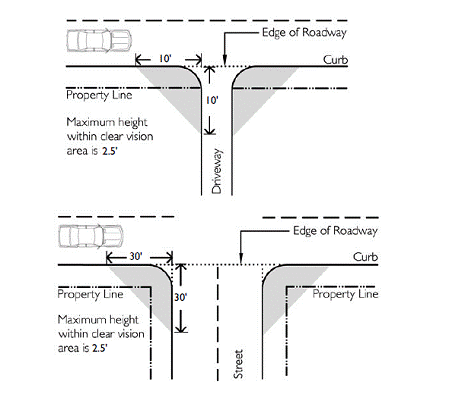18.105.055 Clear vision at intersections.
The purpose of this section is to maintain clear vision areas at intersections in order to protect the safety and welfare of the public in their use of city streets.
A. No person shall maintain or allow to exist on property which they own or which is in their possession or control trees, shrubs, hedges, or other vegetation or projecting overhanging limbs thereof, which obstruct the view necessary for safe operation of motor vehicles or otherwise cause danger to the public in the use of city streets. It shall be the duty of the person who owns, possesses, or controls the property to remove or trim and keep trimmed any obstructions to the view.
B. A clear vision area shall be maintained at all driveways and accessways and on the corners of all property adjacent to an intersection.
C. A clear vision area shall contain no planting, fence, wall, structure, or temporary or permanent obstruction, except for an occasional utility pole, except when the height of the obstruction does not exceed two and one-half feet in height, measured from the top of the curb, or where no curb exists, from the street centerline grade. Trees exceeding this height may be located in this area; provided, all branches and foliage are removed to the height of eight feet above the grade. Open wire fencing that does not obscure sight is allowed to a maximum height of six feet.
D. The clear vision area for all street intersections and all street and railroad intersections shall be that area described in the most recent edition of the “AASHTO Policy on Geometric Design of Highways and Streets.” The clear vision area for all corner lots shall be that area within a 30-foot radius from where the lot line and the edge of a street intersect. The clear vision area for all driveways shall be that area within a 10-foot radius from where the driveway and the edge of a street intersect.

E. Modification of this computation may be made by the city engineer after considering the standards set forth in the most recent edition of the “AASHTO Policy on Geometric Design of Highways and Streets” and taking into consideration the type of intersection, site characteristics, types of vehicle controls, vehicle speed, and traffic volumes adjacent to the clear vision area.
F. The provisions of this section relate to safety. They shall not be modified by variance and are not subject to appeal. [Ord. 966 § 2 (Exh. B), 2021.]